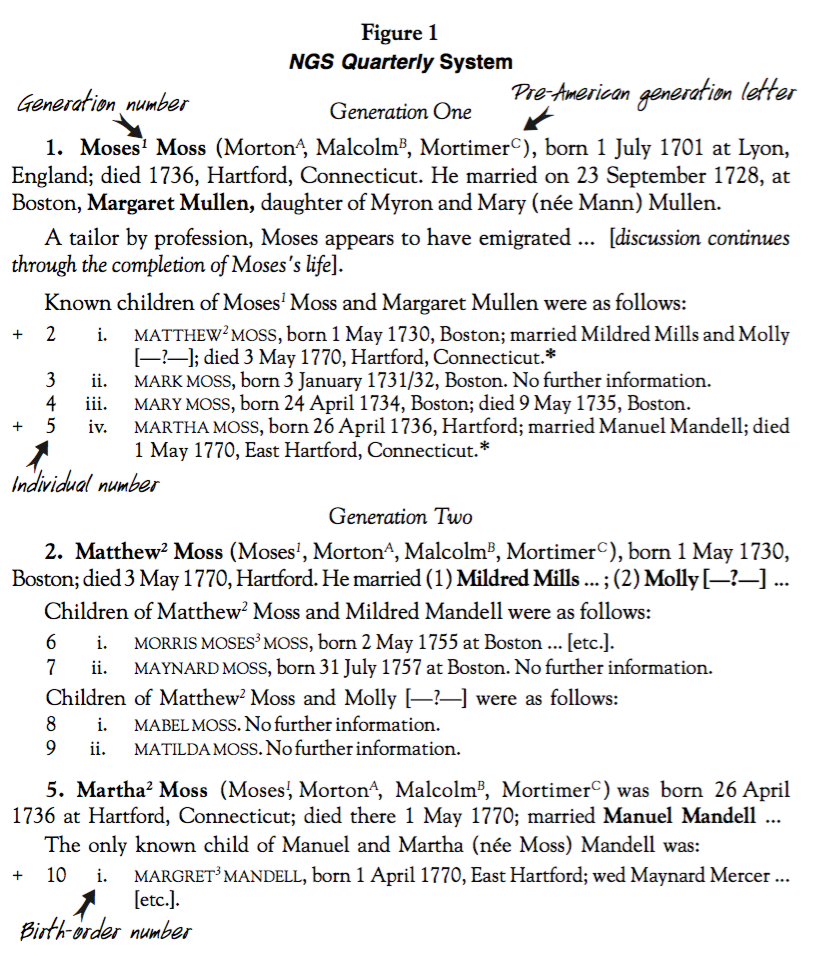Descendancy studies
Descendancy reports typically begin with the first ancestor for which all basic vital information is well established. This is often the immigrant to the US.
Numbers at the top of each report prefixed with an alpha (α) are Ahnentafel numbers from the perspective of my children.
Reports are written in NGSQ ("Modified Register") style, which is one of the most common systems used in genealogy.
Some features of this style of report are:
- Each person is assigned a number, beginning with #1 for the earliest ancestor.
- Generation numbers begin at one for the first immigrant to the US. Non-immigrant generations begin with A and work backward. These appear as headings, but also small, italicized superscripts after a given name.
- Generation numbers are also used as part of a "lineage guide" in an
- Small roman numerals are used to number children in their birth order.
- If a child's number has a + before it, this indicates that they have a more extensive entry further down on the page. Individuals are typically carried forward only when they have known children.
- Finally, NGSQ-style makes use of generation numbers (which help keep lineage clear in a long report). An individuals’ generation number is shown in italics after their given name, and their ancestors are listed in parentheses following, each with their generation number.

Place names often include the county. This is because many records of genealogical significance are stored at the county level. Also, in some cases, two counties contain a similarly-named town.
Dates are given in the standard format for genealogy, which is day—month—year.
However, I have been lazy. Place names have not (yet?) been standardized for historical accuracy, and dates on the Julian calendar have been treated just like Gregorian dates.
The goal is to have all citations meet the standards of Evidence Explained, but this is not (yet?) always the case.
Ahnentafels
Pedigree reports use Ahnentafel numbering, with my children as the intitial subject, “1.”
Ahnentafel is a German word that translates as “ancestor table” or, literally, a list of one’s ancestors. An Ahnentafel is a list of ancestors with each one numbered in a sequential manner that makes it easy to calculate relationships.
The Ahnentafel method is the most common method of numbering ancestors. It is also known as “the Eytzinger Method,” for Michaël Eytzinger, the Austrian-born historian who first published the principles of the system in 1590, “the Sosa Method,” named for Jerónimo de Sosa, the Spanish genealogist who popularized the numbering system in his work Noticia de la gran casa de los marqueses de Villafranca in 1676, and “the Sosa–Stradonitz Method,” for Stephan Kekulé von Stradonitz, who published his interpretation of Sosa's method in his Ahnentafel-atlas in 1898.
- The initial subject is always “1,” whether male or female.
- The father of each person is assigned a number equal to double the child’s number.
- The mother of each person is assigned a number equal to double the child’s number plus one.
- As a result, the number of any child is one-half that of their parent, ignoring any remainder.
It may help to know that an ahnentafel number is a binary representation of an ancestor. You can write down the digit “1" to represent the initial subject, and, from left to right, a "0" for each "father" and "1" for each “mother,” ending with the ancestor of interest. So, a person’s mother's mother's father's father's father's mother's father's father's father's father's father's mother would be 1110001000001 in binary representation, or 7233 in decimal, which would be their ahnentafel number.
Each prior generation has double the number of ancestors of the more recent generation. So, there are four grandparents, eight great-grandparents, 16 great-great-grandparents and so on. Double any person’s number to identify the father. Multiply by two and add one to find the mother.
For example, the parents of ancestor 12 would be 24 and 25. Individual 33 is the wife of 32 (the paternal great-great-great grandparents). Half of 32 is 16 (the great-great grandfather); 16 + 1 is the great-great-grandmother; halve 16 to 8 to arrive at the great-grandfather, and add one to get 9, the great-grandmother.
We can also work backwards and find what the relation is. For example 116 is 1110100 in binary and would refer to the initial subject's mother's mother's father's mother's father's father.
Stephen P. Morse has an anhentafel calculator online.